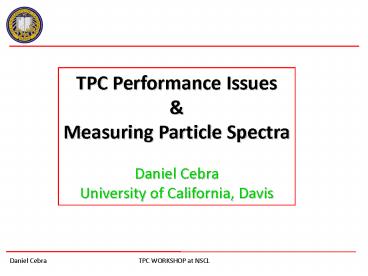TPC Performance Issues PowerPoint PPT Presentation
1 / 27
Title: TPC Performance Issues
1
TPC Performance Issues Measuring Particle
Spectra Daniel Cebra University of California,
Davis
2
TPC Issues and Measuring Charged Particle
Spectra
- Drift and Diffusion in the Detector Gas
- gt Ionization Cloud at the Anode Wires
- Imaging of the Ionization Cloud on the Pad Row
- gt Spatial Resolutions
- Spatial Resolutions and Track Lengths
- gt Momentum Resolutions
- Signal Collection, Amplification, and Sampling
- gt dEdx Resolution
- Momentum Resolution and dEdx Resolution
- gt Particle Identification
- PID, Acceptances, and Efficiencies
- gt Measured Particle Spectra
3
Drift velocity
Drift of electrons in E- and B-fields (Langevin)
Vd is typically 5 cm/ms for gases like Ar(90)
CH4(10) Electrons tend to follow the magnetic
field lines (vt) gtgt 1
4
TPC coordinates Resolutions
Same effects as for PRW are expected but
statistics of drifting electrons must be now
considered
electronics, calibration, signal-to-noise
angular pad effect (dominant for small momentum
tracks)
angular wire effect
diffusion term
forward tracks -gt longer pulses -gt worse
resolution
5
Spatial Resolution STAR TPC
- Position resolution
- 500 mm in r-f direction
- 2 mm in the z direction
sA 440
- 2-Track resolution
- 2.5 cm
6
Spatial Resolutions ALEPH TPC
6
7
Spatial Resolutions ALEPH TPC
8
Momentum Resolution
At STAR, resolution is 3 at 100 MeV
Multiple Scattering Term
Tracking Term
P momentum st transverse resolution e
charge of an electron B magnetic field n
number of spatial measures s track length LR
radiation length B velocity
For STAR, the predicted momentum resolution is
1.4 at pt of 400 MeV. From tracking the
resolution gets about 1 worse for each
additional GeV
9
Momentum Resolution
- Momentum resolution
- 2 , 1 GeV/c lt pt lt 5 GeV/c
10
dE/dx Resolution
From Allison and Cobb, Ann. Rev. Nucl. Part. Sci.
30, 253 (1980)
N number of dEdx samples P pressures in
atomspheres h pad length (in cm)
11
Particle Identification by dE/dx
- Energy loss (dE/dx) depends on the particle
velocity. - The mass of the particle can be identified by
measuring simultaneously momentum and dE/dx (ion
pairs produced) - Particle identification easy in the
non-relativistic region - PID is more challenging in the relativistic rise
region - Major problem is the large Landau fluctuations on
a single dE/dx sample. - 60 for 4 cm pad
- 120 for 4 mm pad
Energy loss (Bethe-Bloch)
mass of electron
charge and velocity of incident particle
mean ionization energy
density effect term
To resolve 9Be from 10Be, Need 10 resolution
12
Particle Identification via dEdx in EOS TPC
- P resolution is a few percent
- dE/dx resolution is 8
- 12 bit ADC (Large Dynamic Range)
- Low gain to avoid saturating Amps with heavy ions
13
Bethe-Bloch Parameterization
- Fit dE/dx distributions for graduated slices in
rigidity. - Convert to ??, where all particle species fall
along the same trajectory. - ?- provides very high ?? data in the relativistic
rise - Use parameterization to predict ltdE/dxgt for
positives above 1 GeV/c.
14
dEdx and Particle ID for E895
15
Double Proton Track Confusion
Triton band and double proton band overlap.
The proportion of deuterons to double protons is
high here so it is safe to find deuteron yields
at these momenta.
16
PID by dE/dx for STAR
h, ? lt 0.5
- dE/dx is described by the Bethe-Bloch function
- We use a 7-parameter Bethe-Bloch function to
calibrate the dE/dx centroids as a function of ??
( p/m) - Distributions of ln(dE/dx) are fitted by 4
Gaussians for ?, K, pr, and e. (with fixed
centroids and widths) - dE/dx resolution from Allison and Cobb
sdE/dx 0.47N-0.46(Ph)-0.32
only 3 free parameters, in most cases
17
Particle Identification dE/dx STAR
resolution 8
18
Particle Identification dE/dx ALEPH
- Good dE/dx resolution requires
- long track length
- large number of samples/track
- good calibration, no noise, ...
- ALEPH resolution
- up to 334 wire samples/track
- truncated (60) mean of samples
- 5 (330 samples)
- NA49 resolution
- truncated (50) mean of clusters
- 38/sqtr(number of clusters)
- from 3 for the longest tracks to 6 measured
with a single TPC
18
19
Negative Pion Spectra
J. Klay et al (E895) PRC68, 054905 (2003).
5 Most Central AuAu
20
Positive Pion Spectra
J. Klay et al (E895) PRC68, 054905 (2003).
5 Most Central AuAu
21
Proton Spectra
Phys. Rev. Lett. 88, 102301 (2002).
5 Most Central AuAu
22
Negative Pion dN/dy
J. Klay et al (E895) PRC68, 054905 (2003).
No reflected data - all measured values!
Gaussian model for 4? yields
23
Positive Pion dN/dy
J. Klay et al (E895) PRC68, 054905 (2003).
No reflected data - all measured values!
Gaussian model for 4? yields
E895 Preliminary - J. Klay, et al.
24
Proton dN/dy
No reflected data - all measured values!
Gaussian model for 4? yields
Phys. Rev. Lett. 88, 102301 (2002).
25
Comparison of STAR Low E Spectra to SPS
STAR 19.6 GeV AuAu
NA44 PRC66, 044907 (2002) - all NA49 PRC66,
054902 (2002) - pim, kam, and kap NA49 PRC69,
024902 (2004) - protons NA49 nucl-ex/0512033 -
protons and anti-protons WA98 PRL83, 926 (1999)
- pi-zero WA98 NPA698, 647 (2002) - pim WA98
PRC67, 014906 (2003) - pim and kam
26
Pion Ratios
STAR PRELIMINARY
KaoS PLB420, 20 (1998) E866 NPA610, 139c
(1996) NA44 PLB372, 339 (1996) WA98
nucl-ex/0607018 STAR PRL92, 112301 (2003)
27
Conclusions
- There is extensive work on understanding TPC
Performance - Spatial resolutions, momentum resolutions, and
dE/dx resolution can be accurately predicted.
Thus one can design the detector to the physics
specifications. - Acceptance and efficiency issues will depend on
the chosen geomtery.

